Lewis “Doc” Brown, his family, and his business were integral parts of the small village of St. Louis Park in its very early days. As a barber, Doc provided an important service to a town full of rough-hewn working men. As a businessman, he provided entertainment, whether it be with his pool hall or his pet alligator. His family worked hard for businesses right here in the Park, and the descendants of Doc and Anna Brown have created lives for themselves that would have made their ancestors proud.
Many thanks to Doc’s grandson Steve Brown for sending photos and vastly improving the scans of photos we have on file!
DOC AND ANNA BROWN
Lewis Leonard “Doc” Brown was born on March 14, 1877, in the Staples-Motley area. His father was from New York and his mother from Carver County, around Chanhassen. His obituary indicated that he had been a barber since he was 16 years old, although the family didn’t know how he was trained. By 1899 he was a barber working in a shop next to the St. Louis Park Hotel.
Anna Wallie Keller was born on February 16, 1881, in New Ulm. She moved to St. Louis Park in 1899 when her parents, Henry and Rosa Keller, were hired by T.B. Walker to manage the St. Louis Park Hotel.
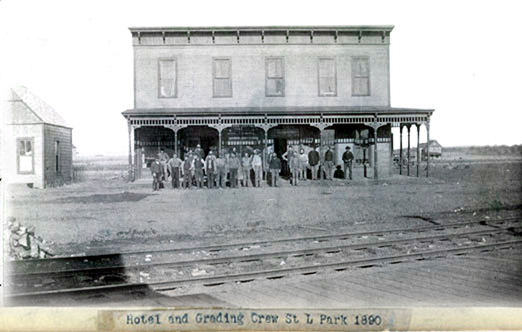
In a 1982 interview, Anna recalls that she and Lewis “met right there in the [hotel] dining room. The first meal after I arrived here.” One of ten children, she worked as a “dining room girl.” When asked what she thought, the first time she saw him, she pointed and said “That’s the one I want!”
The 1900 census lists ten boarders at the St. Louis Park Hotel, including Lewis Brown, then 23. Although 19 year-old Anna might have had her pick of the boarders in her parents’ and other hotels full of male workers, she had her way and she and Doc were married on July 7, 1902. The ceremony and reception were held at the Hotel.
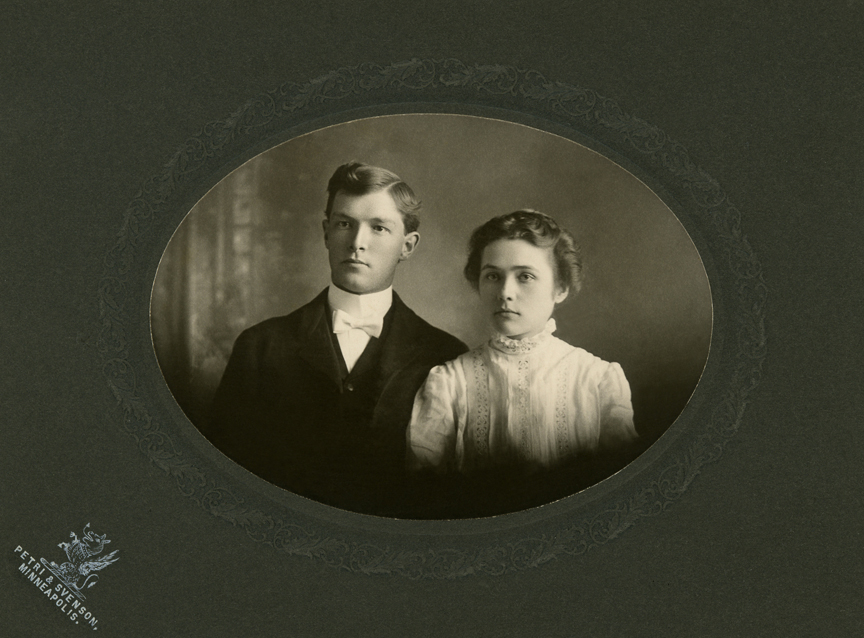
The couple first lived at 6018 Goodrich Ave., a house built in 1898 and rented from Sarah Hamilton.
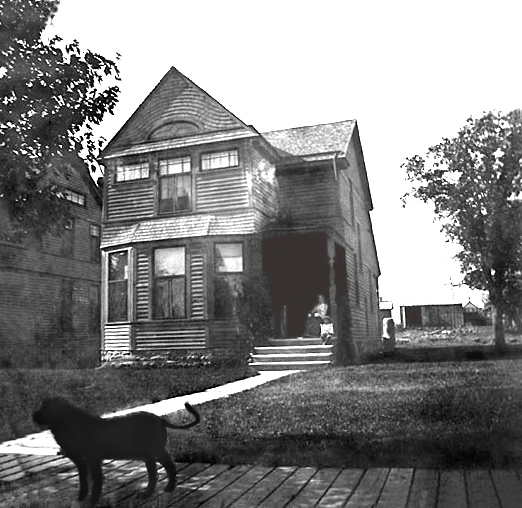
In 1923 the family moved to what is now 3764 Brunswick Ave.
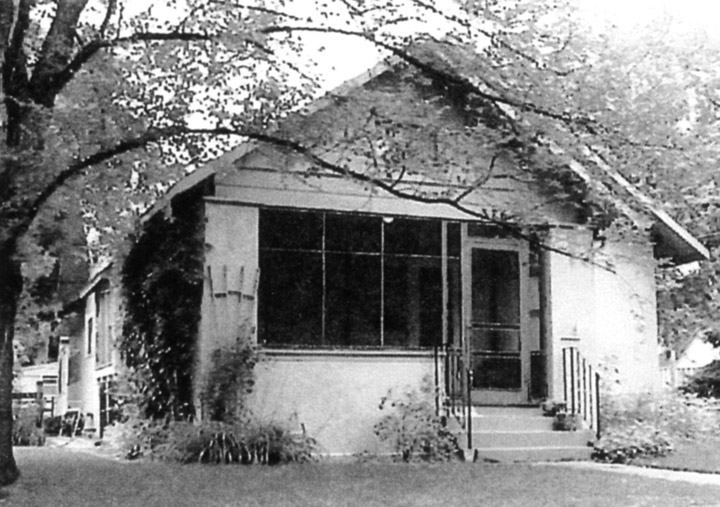
DOC’s CHILDREN
Doc and Anna had seven children. Keep in mind that this was an era where everyone had a nickname!
Wallace Albert, born June 25, 1903. Wallace married Pearl Isabel Peterson on November 2, 1931, and son James W. was born in 1933. Their first home was what James describes as a “tarpaper shack” – the address given in the directory is 4012 Toledo (possibly the future site of Most Holy Trinity Church). In about 1941 they moved to 3754 Colorado, a home owned by Wallace’s sister Una. James tells the story that the rent was $18/month, and when Una raised it to $18.50, Pearl was livid! Wallace served in the Navy (Seabees) from September 17, 1942 to October 1, 1945. He worked for the Creosote Plant before and after the service, but in 1952 he went to work for the U.S. Post Office for decades. Pearl died on February 21, 1963, and Wallace died on November 22, 1987, at the age of 84. James left Minnesota in 1969 and traveled the country as an executive for the Burroughs Corporation, retiring to Phoenix.
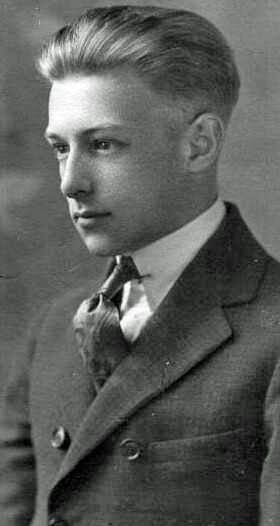
Monroe August, born on July 3, 1905. Monroe married Lola Theresa Triplett, and daughter Carol was born in 1933. In 1935-1940 they lived at 3024 Monterey Ave. in St. Louis Park, a house built in 1924. He died on November 23, 1978, at the age of 73.
Rosalia Katherine “Girlie,” born on September 16, 1907. Rosalia married Elmer J. Graff in about 1929 in Wabasha. Graff died in 1969, and Rosalia died on August 22, 1995, in Minneapolis, at the age of 88.
Lewis John, (“Huns”); born April 20, 1910. Lewis’s wife’s name was Julia, and they had a son Lewis John, Jr., born in about 1938. They lived in St. Louis Park in 1935, and had moved to 3745 Harriet Ave. in Minneapolis by 1940. Lewis worked as a “moulder helper” in a foundry in 1940. He died on October 7, 1992, in Albuquerque, at the age of 82.
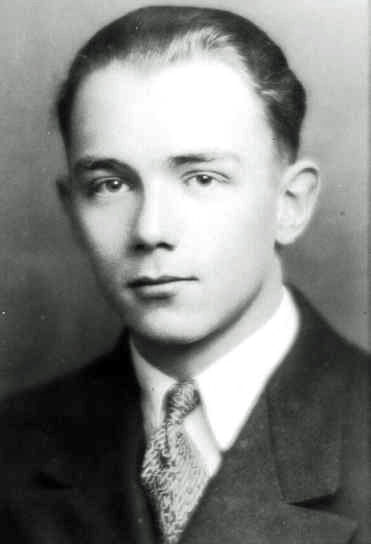
Una Alice “Toots,” born on May 29, 1912. She married Stanley D. Keeley, who was born on March 2, 1910. Their son Stanley Jon Keeley was born on January 5, 1939. In 1940 the young family lived with her in-laws, John and Jenny Keeley; the 1940 Census gives the address at 3846 Natchez. Both John and Stanley Keeley were working for the WPA. Stanley enlisted in the Army in April 1944. At some point Una was a Corporal in the U.S. Army. Stanley died in February 1977. Una died on October 4, 1982 in St. Louis Park, at the age of 70. They are both buried at Fort Snelling.
Ann Marie, born January 16, 1915; died February 19, 1999 in St. Paul, at the age of 84. Ann never married, living with her mother Anna for most of her life. She worked at the IRS for 30 years.
Benjamin B., (“Bud”); born Mach 31, 1916; died April 21, 2014, at the age of 98. Ben disavowed having a middle name, but sheepishly admitted that it was Beverly. He worked at the Creosote Plan four four years after graduating from high school in 1934, served in the Seabees during WW II, and worked for the Post Office from 1946 to 1975. He married Virgnia in 1946 and had four children: Steven Lewis, Douglas Owen, Beverly Ann, and Richard Allen. Virginia died in 1985 and he married Adele in 1986. Ben has written an extensive autobiography, which is on file at the Historical Society.
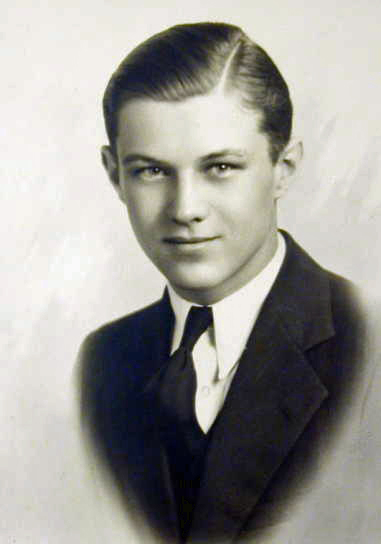
An interesting note is that all four Brown boys worked at the Creosote Plant. In 1930:
- Wallace was a purchasing agent
- Monroe was a timekeeper
- Lewis was a stock clerk
(Monroe worked at the plant just short of 50 years; Wallace for about 18 years; Ben 1936-1941; and one for 35 years)
In 1940:
- Monroe worked in the sample laboratory
- Wallace was a laborer
- Ben was cleaning stills
DOC BROWN’S BARBER SHOP AND POOL ROOM
Doc was a barber by trade (the nickname Doc was common for barbers), and his first barbershop was across from Minneapolis and St. Louis Depot, immediately east of the St. Louis Park Hotel.
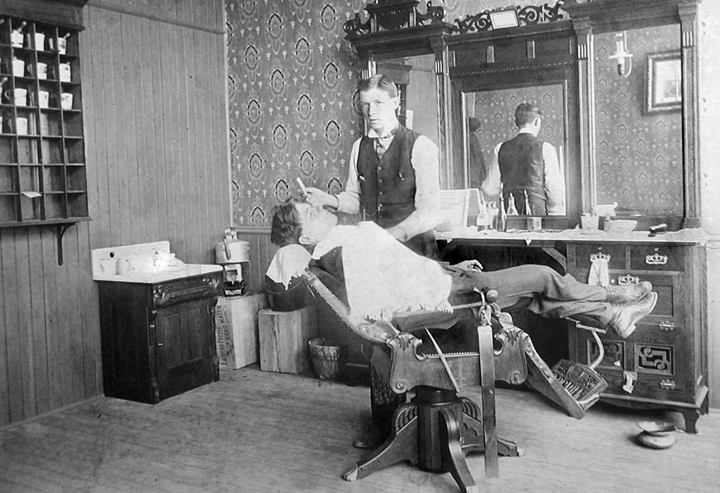
THE MOVE TO THE BRICK BLOCK
Doc moved the shop to Walker Street, known as the “Brick Block” and the commercial hub of the young village. There were two large buildings with storefronts that faced each other on the street: the Hamilton Building, which burned down in 1958, and the Walker building, which still stands today.
Where and when this move was made is inconclusive. unfortunately, no directories that we know of were published for the village until 1933.
One source says that his first location on the Brick Block was the East Room in the Hamilton Building. Doc’s son Ben mentions that that he moved to the Walker Building after he was married in 1902.
As for the date of the move, one source says that it may have been as early as 1890. Ben thought it was after Doc and Anna were married in 1902.
One source says that he was at the Walker Building from 1904 to 1907 and again from 1910 to 1942.
The 1914 tornado pretty much tore that building apart (he had no insurance), and in 1915 he moved across the street to the Walker Building.
There was a horrendous fire at the Walker building on February 3, 1917, and the Brown and White Barber Shop was listed as a tenant in the newspaper report.
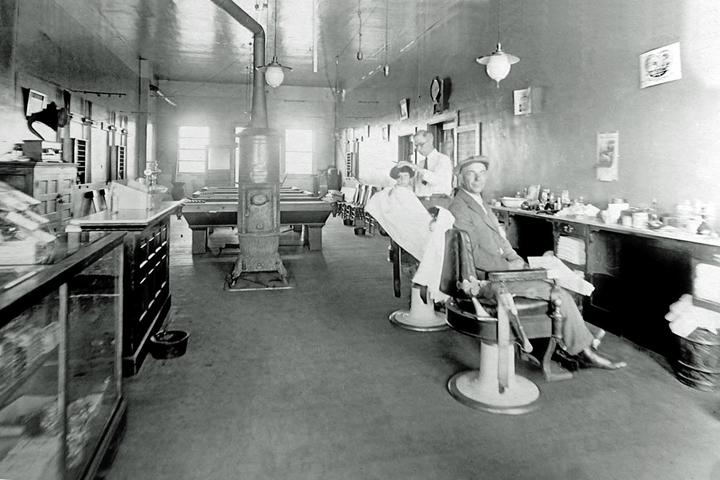
On June 2, 1925, a tornado ripped through the shop.
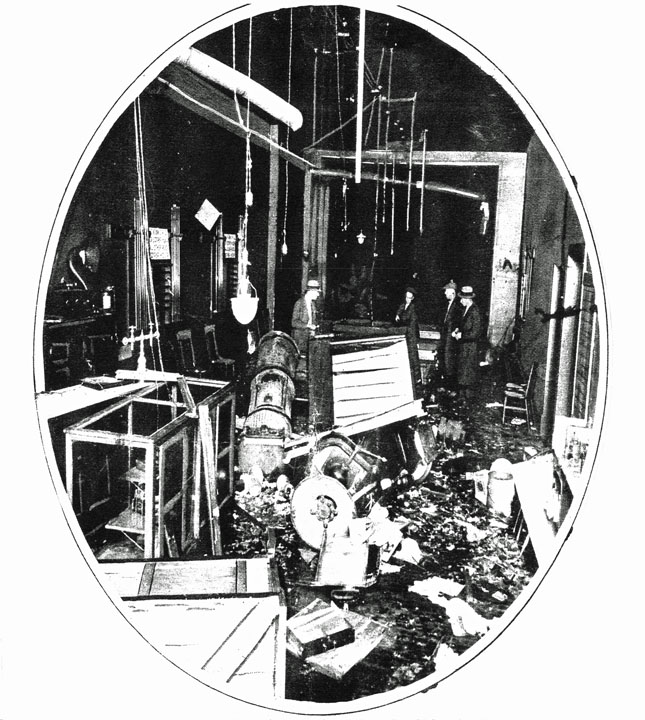
The caption reads:
INTERIOR OF THE L. L. BROWN POOL HALL
at St. Louis Park after the storm had passed. The front of the building was blown in, swished through the store and out the back of the place, carrying five men with it. The other occupants of the hall picked themselves up under a litter of tables and barber chairs.
Bob Reiss remembered:
A wall clock was blown off the wall and smashed. It looked like a hopeless wreck. Someone printed the time and date on the face when it was stopped by the tornado. The clock hung on the wall for a while until Doc took it apart and washed the works in kerosene and put it back on the wall It started to run and continued running for many years.
MEMORIES OF THE BARBER SHOP
Bob Reiss:
In front of the shop was a barber pole that was bolted to the sidewalk. It was a tall pole with a revolving barber pole enclosed in glass. Every morning after arriving at the shop, it had to be wound so it would revolve. The shop closed at 7:00 PM and Doc did not want it revolving after that. By trial and error he found the right formula. By winding the barber pole seven and a half times, it would stop completely by 7:00 o’clock.
Don Swenson’s father ran his grocery store next to the barber shop starting in 1923. Don had his first haircut in about 1930, and remembered that the final step in the process was a dowsing with Lucky Tiger Tonic; decades later Don remembered the beautiful lady on the bottle and the pungent odor of the concoction. More from Don:
The barber shop was equipped with good quality oak cabinets which had marble tops and generous wall mirrors. The matched equipment was probably vintage 1910. There were two standard barber chairs, although he used only one. A waiting customer would often climb into the vacant chair. It was a rarity to see a woman in the place. When I was a small child, Dad would bring me into the shop and Doc would pull the booster board from under the counter and place it on the arms of the chair. Dad would go back to work next door and reappear in about twenty minutes to pay Doc for his services. Doc charged fifty cents for a haircut. His competition was another barber about a block away at the end of the car line, who charged 35 cents. Our family never used a barber other than Doc.
Doc was a pleasant, stately gentleman who was not your typical talkative barber. He was always seen in his white barber’s coat, and his professional appearance may have been the reason for his nickname. American Linen Supply Company made regular deliveries of the rented coat, linens to cover the laps of customers, and the neat stacks of white towels for customers willing to pay for a shave. Doc was adept at using the strop for his straight edge razors.
THE POOL HALL
Don Swenson:
The barber shop was only one part of Doc Brown’s modest empire. Upon entering the front door you found yourself in the confectionery/tobacco part of the store. The barber shop was on the right behind swinging doors and a floor to ceiling glass and wood partition. Doc was usually on duty by himself. He could be cutting hair and still see what was going on in the rest of the store, or he could step away from the barber chair conveniently to wait on a tobacco customer.
Cigarettes and other items were kept in surdy oak cabinets on the wall. There were large candy and cigar display cases. You could order a bottle of pop at the marble-topped stand-up counter. On the rare occasion when I had a nickel to spend, my favorite was creme soda.
My Dad was a chain smoker, and his cigarettes always came from Doc Brown. As part of his World War I experience, he smoked a little-known brand. The package, identified with an Indian Chief complete with headdress, was called “ONE ELEVEN.” Doc reported that his wholesale supplier had only one shop in the Twin Cities that carried the brand, and it was Doc’s place – and Doc had only one customer for the brand, Nels Nelson. Eventually Dad determined that the smokes were so stale that they tasted more and more like ground-up horse leavings. He couldn’t stand them anymore. He switched to the Raleigh brand because of the coupon on the back which held the promise of handsome and valuable premiums. So long as Doc had his place, the Swenson and Redeen grocery next door didn’t carry cigarettes in deference to a good neighbor.
In back of the barber ship and the tobacco/confectionery section were three or four pool tables. The high ceilings and dingy walls were lighted only by small fixtures above the pool tables. Cue and ball racks were on the walls. Cigarettes were often stomped out on the wood floors. Spittoons were placed in strategic locations. It could have been one of those dens of iniquity made famous in “The Music Man.” Dad and Carl [Redeen] never patronized the pool hall, but my impression was that they had spent time in similar establishments in their younger years. My mother was very direct about her two sons not getting involved in whatever it was that went on in a pool hall. So far as I know, Doc ran a good establishment that was patronized as a “hang out” for the younger men in the community, but never a real trouble spot.
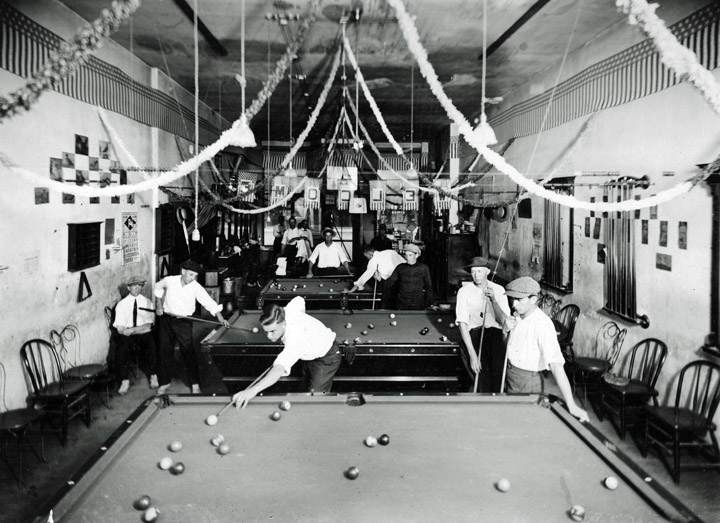
DOC’S ALLIGATOR
The pet alligator in the window of Doc’s Barber Shop may seem like a (sub)urban myth, but an article and photo in the Minneapolis Journal dated May 30, 1929, tells the tale in quite flowery language.
The reptile has been in the possession of Mr. Brown for three years. He received him from a friend in Florida. It was sent by John Staples, at one time a resident of St. Louis Park, and is thought to be in the neighborhood of 14 years of age. It measures nearly 30 inches in length, and has outgrown his tank, a discarded kitchen sink with a southern exposure, which occupies a prominent place in the front window. Mr. Brown says his charge has gained an average of two inches every year and is not yet full grown.
The alligator declined to be interviewed, being in the midst of his midweek bath and manicure. Contrary to what one might expect of a reptile whose natural habitat is a muddy, sluggish, slimy swamp, this particular one seems to actually relish his scrubbing and change of water in his tank. He stretched himself out to his fullest length, and if one’s imagination is vivid enough, managed a grotesque smile as his caretaker applied the stiff-bristled brush to his scaly back.
The article went on to say that the alligator (no name was given) did not eat during the winter, having had his last meal on March 31, 1928, and only on April 6, 1929, did he feel like “sitting up and taking nourishment.” His diet consisted of raw meat, and was fed as much as he wanted, once or twice a week. The report said that captivity did not seem to have any ill effects on the animal, except that he could no longer get in and out of his tank on his own, and had to use a specially constructed runway.
Bob Reiss again:
Doc did not know what to do with the alligator, so he fixed a spot for it in his front window where it lived for thirteen years. Everybody who lived in the Park in the 1930s knew about Doc’s alligator. No one seems to remember what happened to the alligator but we have recently heard rumors that it may still be alive. If it had escaped it could be possible because alligators live 50-60 years. We would like to find this former resident. We do not know if he (or she) decided to try to get back to Florida – If so, it might still be on the way, or it might have just found its way to one of the lakes, such as Minnetonka. We need your help. Please report any alligator sighting. Do not forget that alligators can grow up to a foot a year so you could be looking for something substantial. We also need any personal information you might have on this alligator. Does it have a name? Is it a he or she and how do you tell? We need this information to make sure we have the right alligator when we find him.
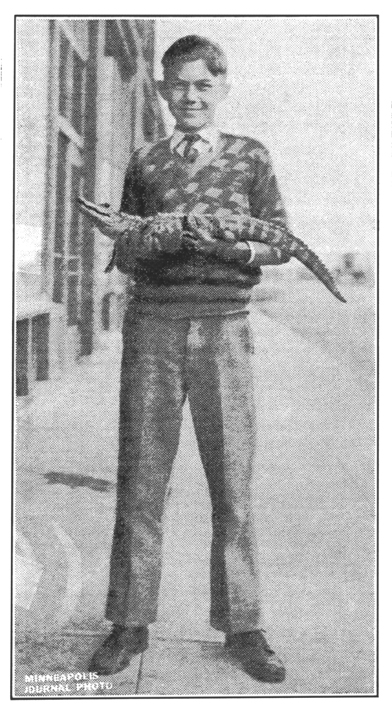
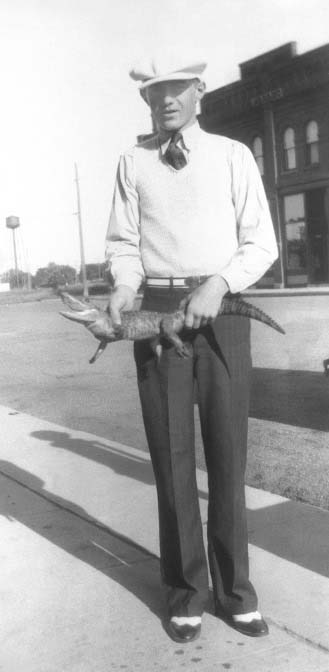
DOC’S CIVIC ACTIVITIES
Although Doc only had an 8th grade education, he served as Village Assessor 1904, 1906, 1907, and 1908. Doc’s son Ben wrote: “I don’t know how good he was in math but one thing he did have is that he had beautiful handwriting. How many people can say that today?”
Among his other activities, he was manager of the St. Louis Park baseball team in 1910 and remained active in baseball in the Park for many years. Ben wrote that in the 1930s Doc was the official scorekeeper for the Park team. “You could take his score book years later and follow the game right through the final out.”
Doc was also a charter member of the Park Rebekah Lodge No. 110, a member of the Oddfellow Lodge, and a member of the Paul Revere Masonic Lodge.
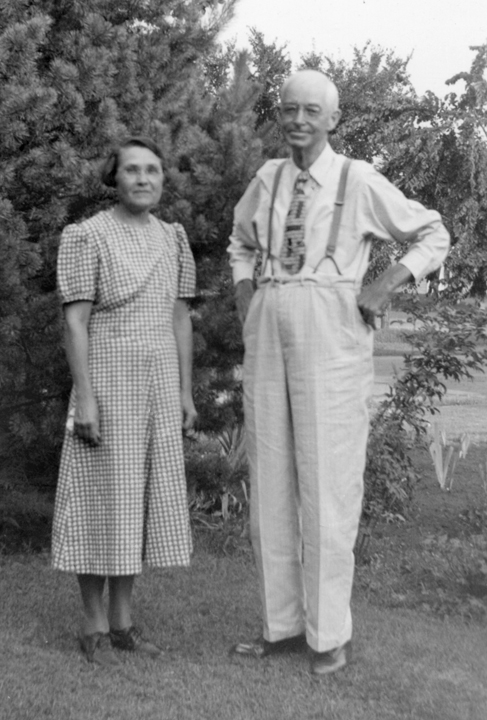
DEATH OF DOC BROWN
Doc contracted cancer in the 1940s, and because his sons were in the service, the business had to be closed.
Don Swenson:
The fixtures were sold and Swenson and Redeen rented the back portion of the store where the pool hall had been. The added space was needed for the expanding meat and grocery business. Elmer Whipps opened a barber shop in the front end of the former Doc Brown establishment. It was the end of an era and Doc’s unusual combination businesses became history.
Doc Brown died on August 27, 1942 at the age of 65. Anna died on February 19, 1985, at the age of 104, just shy of her next birthday.
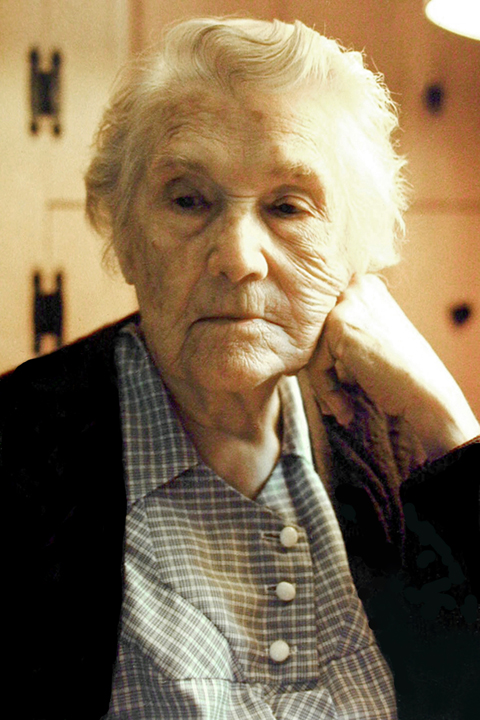
In March 2000 a tree was planted in Jorvig Park in memory of Doc and Anna Brown.
